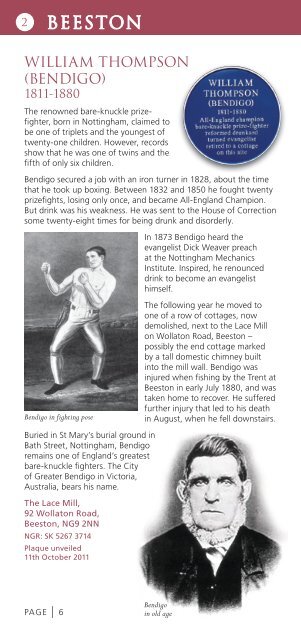GUIDE TO THE BLUE PLAQUES
BP%20final%20proof.2016.05.03
BP%20final%20proof.2016.05.03
Create successful ePaper yourself
Turn your PDF publications into a flip-book with our unique Google optimized e-Paper software.
2 BEES<strong>TO</strong>N<br />
WILLIAM THOMPSON<br />
(BENDIGO)<br />
1811-1880<br />
The renowned bare-knuckle prizefighter,<br />
born in Nottingham, claimed to<br />
be one of triplets and the youngest of<br />
twenty-one children. However, records<br />
show that he was one of twins and the<br />
fifth of only six children.<br />
Bendigo secured a job with an iron turner in 1828, about the time<br />
that he took up boxing. Between 1832 and 1850 he fought twenty<br />
prizefights, losing only once, and became All-England Champion.<br />
But drink was his weakness. He was sent to the House of Correction<br />
some twenty-eight times for being drunk and disorderly.<br />
Bendigo in fighting pose<br />
Buried in St Mary’s burial ground in<br />
Bath Street, Nottingham, Bendigo<br />
remains one of England’s greatest<br />
bare-knuckle fighters. The City<br />
of Greater Bendigo in Victoria,<br />
Australia, bears his name.<br />
The Lace Mill,<br />
92 Wollaton Road,<br />
Beeston, NG9 2NN<br />
NGR: SK 5267 3714<br />
Plaque unveiled<br />
11th October 2011<br />
In 1873 Bendigo heard the<br />
evangelist Dick Weaver preach<br />
at the Nottingham Mechanics<br />
Institute. Inspired, he renounced<br />
drink to become an evangelist<br />
himself.<br />
The following year he moved to<br />
one of a row of cottages, now<br />
demolished, next to the Lace Mill<br />
on Wollaton Road, Beeston –<br />
possibly the end cottage marked<br />
by a tall domestic chimney built<br />
into the mill wall. Bendigo was<br />
injured when fishing by the Trent at<br />
Beeston in early July 1880, and was<br />
taken home to recover. He suffered<br />
further injury that led to his death<br />
in August, when he fell downstairs.<br />
SITE OF SWISS MILLS<br />
1886-1984<br />
BEES<strong>TO</strong>N 3<br />
The Swiss Mills owed their origin to the<br />
Pollards, one of Beeston’s great lacemaking<br />
families. John Pollard (1838-<br />
1903) added the Wollaton Road building<br />
to a group of older works in the Cross<br />
Street/Villa Street area in 1886. John was<br />
the second of four generations of the Pollard<br />
family – Thomas, John, Arthur and John – that made lace on this<br />
site from the 1840s until 1953. They started modestly with handoperated<br />
machines, gradually embracing steam power.<br />
Swiss Mills with John Pollard Junior, 1950s, courtesy of Ernest Pollard<br />
When lace demand was high, the machines worked from 4am until<br />
midnight, reputedly causing the building to sway.<br />
The plain Swiss Mills stood in contrast to its Anglo Scotian Mills<br />
neighbour, reflecting the characters of the men who built them<br />
– the practical, earthy John Pollard and the flamboyant Frank<br />
Wilkinson (plaque 1).<br />
The Pollard business, noted for fine quality Leavers lace, peaked in<br />
the early 20th century. A clock and belfry, incorporating The Ten<br />
Bell (plaque 4) were added in 1903, and in 1909 Pollards bought<br />
Anglo Scotian Mills. Arthur Pollard, regarded in Nottingham as<br />
the most gifted lace man of his time, died in 1952. His son John<br />
oversaw the end of lace making by the family in Beeston shortly<br />
afterwards.<br />
A spectacular fire on 29th March 1984 finally destroyed a landmark<br />
and the legacy of one of Beeston’s most successful lace families.<br />
The origin of the name Swiss Mills is currently a mystery.<br />
46 Wollaton Road, Beeston, NG9 2NR<br />
NGR: SK 5276 3703<br />
Plaque unveiled 27th May 2014<br />
PAGE | 6<br />
Bendigo<br />
in old age<br />
PAGE | 7


